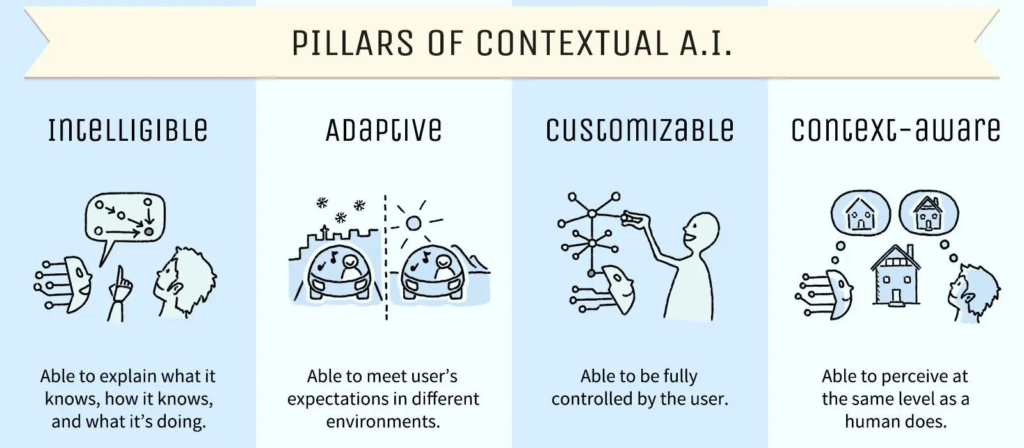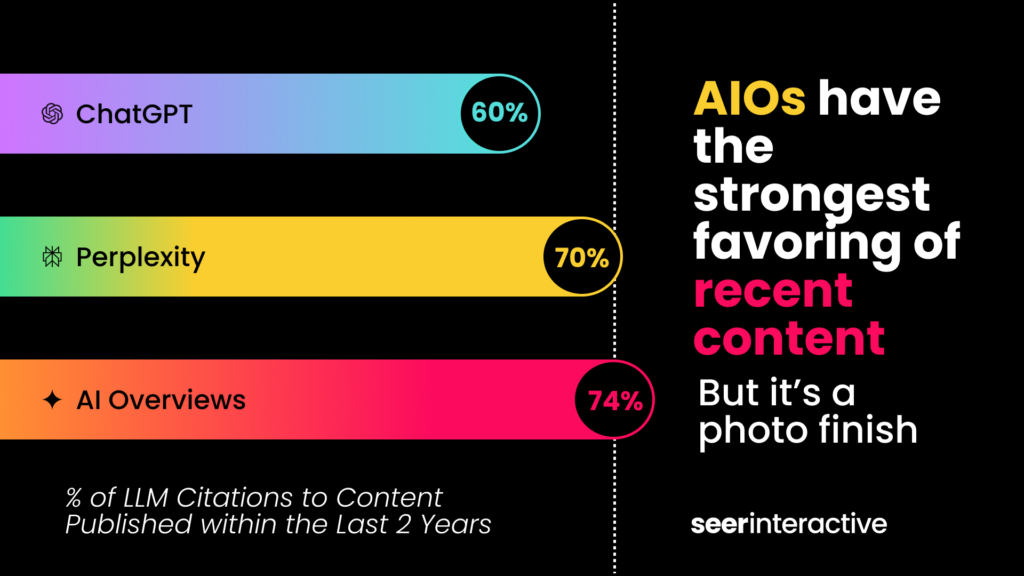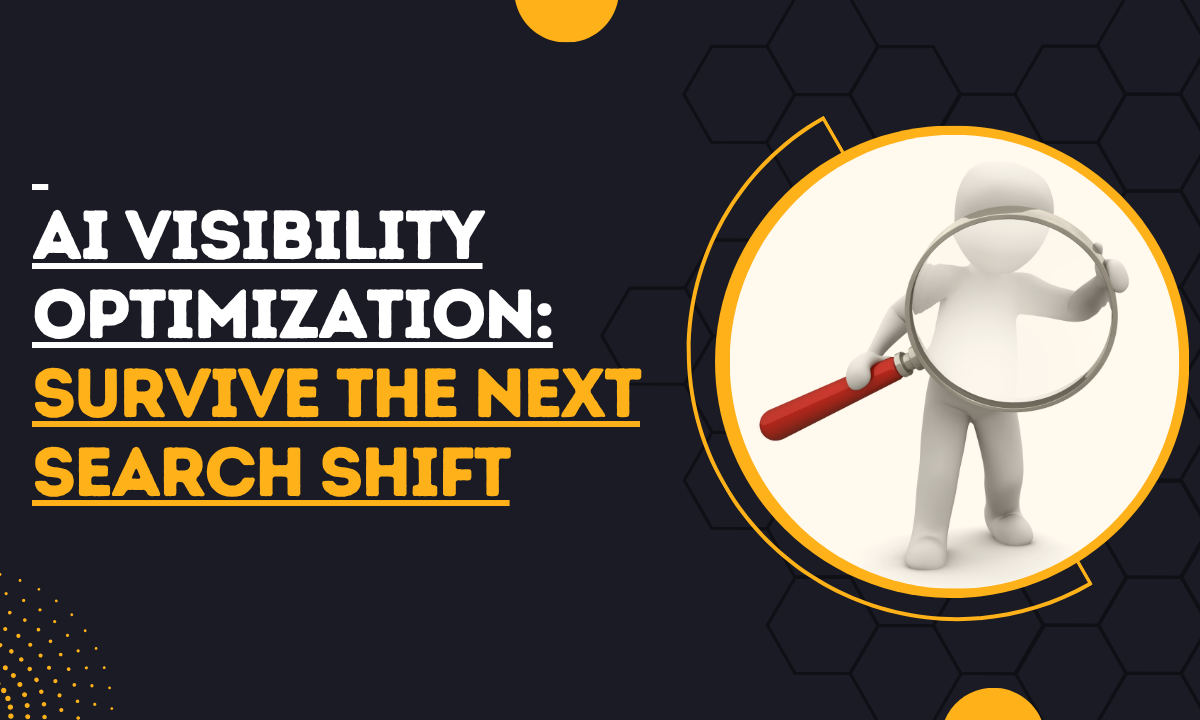AI Visibility Optimization: Survive the Next Search Shift
AI visibility optimization is fast becoming the new frontier of digital discovery. Search is evolving faster than ever, as artificial intelligence reshapes how people find information, products, and even you.
In this new era, visibility isn’t earned through keywords alone — it’s sustained through credibility, clarity, and contextual depth.
With 27% of global enterprises already integrating AI search tools into their knowledge systems, the rules of discoverability have changed.
The real challenge now isn’t chasing algorithms — it’s teaching algorithms how to recognize, trust, and elevate your unique digital presence.
AI visibility optimization is emerging as the new frontier.
It’s not about chasing algorithms; it’s about teaching algorithms how to see you.
1. What Exactly Is AI Visibility Optimization?
Is traditional SEO dead?
Not yet—but it’s transforming.
AI visibility optimization means ensuring your content is recognizable, relevant, and retrievable by AI-driven systems like Google’s SGE, ChatGPT, or Perplexity.
These systems no longer just “crawl” keywords—they interpret meaning, authority, and intent.
Think of it this way: SEO helped humans find you through search engines.
AI visibility optimization helps AI find you across every digital interface.
If you’ve ever asked ChatGPT or Gemini a question, you’ve seen the future of search.

AI doesn’t show 10 links—it shows one synthesized answer.
If your voice isn’t in that synthesis, you don’t exist there.
That’s why AI visibility optimization isn’t optional—it’s survival.
2. Why This Shift Is Happening Now
According to Google’s July 2025 data, AI-powered search features now handle 78% of all queries.
Why now?
Because AI search is no longer theoretical—it’s operational.
Voice, chat, and contextual recommendations are replacing the old “type and click” habit.
Search engines have turned into answer engines. They don’t send traffic to websites; they absorb content to generate direct responses.
The implication is massive: visibility is no longer about ranking—it’s about representation.
AI visibility optimization ensures your brand’s insights become part of those AI-generated answers.
It’s about being present in the machine’s understanding of your niche.
And in this new search ecosystem, that presence determines profit, authority, and even credibility.
3. How to Build AI-Friendly Content
How do you make your content visible to AI?
By writing for trust not for AI search engines only; for understanding, not just for keywords.
AI visibility optimization is no longer about stuffing phrases or gaming algorithms.
It’s about clarity, coherence, and contextual richness.
Think of it this way — AI systems read your text the way humans read tone. They look for meaning, structure, and signs of value.
If your content feels intelligent and natural, AI systems recognize it as such.
Here’s how to align your writing with that logic.
Structure Matters
An article on Surfer SEO clearly states that “AI search optimization is the process of tailoring your website content, structure, and authority so that it performs well in AI-powered search environments, particularly those driven by large language models“.
AI doesn’t just read — it interprets.
Your structure is like a roadmap guiding that interpretation.
Use clear headings, definitions, and logical flow to help AI understand the relationships between your ideas.
When your article moves smoothly from one section to another, it signals coherence and intent.
For instance, if you’re writing about AI writing tools, start with what they are, move to how they work, and end with examples like Jasper or Copy.ai.
This flow mimics how humans learn, which makes AI categorize your content as well-organized and valuable.
Avoid random paragraph breaks or overly long sections. Instead, use short, distinct blocks with subheadings.
AI models learn meaning through hierarchy — titles, bullet points, and transitions.
In fact, structure tells both humans and machines: this content has order and purpose.
Write Like You’re Explaining to a Smart Friend
Ever notice how the best teachers simplify complex ideas without making them sound childish?
That’s your goal.
Be creative and write like you’re talking to a curious friend — conversational, but not careless. Simplify without diluting meaning.
Let’s say you’re describing “machine learning.”
Instead of writing, “Machine learning is a subfield of artificial intelligence that utilizes statistical techniques…” — say, “Machine learning is how computers learn from examples, kind of like how you get better at chess by playing more games.”
That tone feels natural, human, and easy to follow.
When you write like that, AI recognizes your text as accessible and emotionally intelligent. Both signals of high-quality, human-like content.
This also goes to ensure non-AI human like competencies are evident in the content.
Remember, clarity beats complexity every time.
Embed Entities and Context

AI thrives on connections.
It understands your topic better when you include related people, tools, and ideas.
Think of these as “semantic anchors” — they link your writing to the broader knowledge graph that AI uses to assess meaning.
If you’re writing about digital marketing, for example, mention tools like HubSpot or Google Analytics, or reference experts like Neil Patel. When you talk about AI creativity, include phrases like ChatGPT, Midjourney, or OpenAI’s GPT models.
These entities give context and make your content more findable.
AI systems look for such interconnections to determine topical authority. The richer your references, the more confidently AI can categorize your piece.
Just make sure your mentions feel natural — don’t name-drop; integrate intelligently.
Add Your Unique Take
This is where your voice becomes your biggest SEO advantage.
AI models are trained on oceans of repetitive data, so when they detect phrasing or perspectives that feel fresh, they mark it as authentic authorship.
Don’t just summarize what others say — interpret it. Add a story, a lesson, or an unpopular opinion.
For example: “While many believe AI will replace writers, I think it will amplify the ones who can think critically.” That single sentence shifts you from an echo to an original.
Your unique framing — your metaphors, tone, and insight — tells AI that a real human is behind the words.
And when your voice stands out, both algorithms and audiences pay attention. The better you express your individuality, the harder it is for AI to ignore you.
4. The Hidden Risks of Ignoring AI Visibility
What happens if you don’t adapt?
You fade.
When search engines transform, they don’t wait for anyone.
In 2000, early businesses ignored websites.
By 2010, many ignored mobile optimization.
In 2025, ignoring AI visibility optimization will be the next big mistake.
Your blog could vanish from recommendations.
Possibly, your brand could be absent from AI summaries.
Your voice could be erased from the digital conversation.
The risk isn’t losing ranking—it’s losing recognition.
AI is now the new gatekeeper. If you’re invisible to it, you’re invisible to your audience.
That’s why mastering AI visibility optimization is like buying future insurance for your digital presence.
5. Practical Steps to Improve AI Visibility
You don’t need a PhD in machine learning to make your content visible to AI systems. What you really need are smarter, consistent habits.
Visibility isn’t about algorithms anymore—it’s about intelligence and intention in how you create, update, and connect your ideas.
Let’s break down the habits that actually move the needle.
Prioritize Semantic SEO
Forget keyword stuffing—it’s outdated.
AI visibility expert Maria Dykstra points out that “SEO is no longer about ranking first in Google. It’s about appearing first in AI systems.”
Today, AI understands meaning through topics and relationships, not isolated terms.
This approach is called semantic SEO, and it’s how you help search engines and AI connect your content with relevant questions people actually ask.
For instance, if you’re writing about “remote work productivity,” include related concepts like time tracking apps, deep work, or burnout prevention.
Group these into topic clusters with internal links
. This signals that you cover the subject deeply, not just at the surface level.
AI tools such as Google’s systems map your topics the same way the human brain connects ideas.
The clearer those connections, the more authority your content earns in search and AI-generated answers.
Create Authoritative Content
AI favors the credible.
Tools like Google’s algorithms now follow the E-E-A-T principle—Expertise, Experience, Authoritativeness, and Trustworthiness.
To show that you deserve visibility, you need to prove your experience, not just claim it. Include real outcomes, short case studies, and specific data points. For example, “
After applying this strategy, we saw a 35% engagement boost within two weeks.”
That kind of proof instantly elevates your credibility. Cite trustworthy sources too—research papers, expert quotes, or respected industry reports.
When your writing feels grounded in real results, AI systems classify it as reliable, which raises both your search visibility and perceived authority.
Optimize for Conversational Queries
Think about how you talk to AI tools. You don’t type “AI visibility optimization best methods”—you ask, “How can I make my content more visible to AI?”
That’s exactly how AI wants your content to read: natural, conversational, and human-centered.
Frame your content around questions and answers.
Use subheadings like “What makes AI trust your content?” or “Why does freshness matter in ranking?”
Then provide clear, concise answers beneath them.
For example, a blog post might start with: “Ever wondered why your older articles no longer rank?”
This instantly engages both the reader and AI, since question-based phrasing mirrors natural search behavior.
Maintain Content Freshness

AI tools thrive on recency.
Outdated pages fade fast because algorithms assume stale data equals lower relevance.
Regularly revisiting and updating your articles sends a signal of active expertise.
You don’t need to rewrite everything—just refresh facts, update examples, or add a new paragraph on emerging trends.
For instance, if you wrote about AI writing tools a year ago, include updates about Claude 3 or ChatGPT’s new features.
Even small updates every few months keep your content alive in the digital bloodstream.
AI rewards sites that behave like living organisms—constantly learning, adapting, and staying current.
Link Strategically
Think of links as neural pathways for your content.
Internal links help AI understand how your ideas interconnect, while external links show that you’re plugged into a wider ecosystem of credible sources.
When writing about “AI content optimization,” for instance, link internally to your post on “semantic SEO” and externally to a reputable source like Search Engine Journal.
This dual approach strengthens your authority network.
AI uses these relationships to map topic relevance, just as your brain links concepts during learning.
Every thoughtful link acts like a breadcrumb, guiding AI toward a richer understanding of your domain authority.
Consistency compounds visibility.
It’s not about gaming the system—it’s about training the system to recognize your value. Each well-structured post, updated resource, and strategic link reinforces your credibility over time.
When you show up with clarity and consistency, AI can’t help but notice.
6. Futureproofing Your Presence
Aligning with How AI Thinks
In the near future advances in AI are likely to disrupt human relevance as well. Can you truly future-proof visibility in such an AI-first era?
Almost.
You do it by aligning with how AI learns, reasons, and ranks.
Today, AI-driven search algorithms don’t just crawl pages; they interpret intent, tone, and authority.
So, AI content discoverability depends on more than keyword placement—it’s about creating content that feels intelligent and trustworthy.
Teaching AI Through Semantic SEO
When you write with semantic SEO strategies in mind, you’re essentially teaching AI what your content means—not just what it says.
Think of it as giving context, not commands.
The clearer your intent, structure, and connections, the easier it becomes for machine learning in SEO systems to interpret and promote your content.
From Technical to Philosophical Optimization
AI visibility optimization isn’t just technical—it’s philosophical.
It’s about entity-based optimization that links your ideas to recognizable concepts, people, and categories.
When you mention related entities naturally—say, connecting “AI content strategy” with “topic clustering for AI SEO”—you help AI understand your authority map.
You’re not gaming the system; you’re training it to trust you.
Building Algorithmic Trust Through Consistency
The more consistently you produce structured, authoritative, and human-toned insights, the more algorithms associate your name or brand with reliability.
This is how algorithmic content ranking evolves—it learns who provides clarity and who repeats noise.
AI’s trust isn’t earned with hype; it’s built through data-backed, context-rich narratives that demonstrate expertise.
Why AI Prefers Depth Over Buzzwords

Source: TradeAlgo
Imagine this: two writers publish similar blogs on the future of search optimization.
One uses precise examples, credible links, and semantic depth.
The other writes generically, repeating buzzwords without real insight.
Guess whose content AI will choose to quote in its next response? The one that helps it understand the world better.
That’s AI-first content strategy in action—writing not just for humans, but for the intelligent systems that now mediate human discovery.
Designing Relevance, Not Luck
Future visibility isn’t luck—it’s design. And design begins with understanding how intelligence—artificial or human—perceives relevance.
Search intent optimization bridges that gap.
When your writing anticipates user curiosity and answers naturally phrased questions, AI recognizes it as valuable.
You’re not chasing keywords; you’re matching cognitive patterns.
Mastering Visibility in the AI Era
Ultimately, content visibility in the AI era depends on how well you balance depth, originality, and clarity. Consistency compounds trust.
Every time you publish something insightful, update an old post, or link ideas contextually, you strengthen your AI content ranking factors.
Visibility becomes less about chasing algorithms and more about nurturing understanding.
The Mindset Behind Lasting Visibility
AI visibility optimization, therefore, isn’t a marketing trick—it’s a mindset.
It’s about teaching both humans and machines to see you as a reliable source of truth.
When you write with precision, authenticity, and semantic intelligence, you don’t just stay visible—you become memorable.
Latest Free & Paid Tools
| Tool | Free/Trial? | Key Features | Details & Explanation |
|---|---|---|---|
| Writesonic AI Visibility Tool | Free tier + paid | Brand presence tracking, visibility score, competitor tracking. | Entry-level tool suitable for small to mid-sized brands. Helps monitor visibility metrics and competitive positioning in AI-driven search environments. |
| Profound (Answer Engine Insights Dashboard) | Paid | Tracks brand mentions across major AI engines, AI crawler visibility, content-optimisation workflows. | Enterprise-grade tool that provides deep insights into how brands appear across AI platforms, helping refine high-level visibility strategies. |
| SE Ranking AEO Tool | Free trial + paid | Monitors brand mentions and links across selected AI answer engines (e.g., ChatGPT, Google AI). | Ideal for mid-sized businesses wanting detailed tracking of brand and link visibility in AI-generated responses. |
| Otterly.AI | Paid | AEO tool to track brand mentions + sentiment in AI answer engines. | Focuses on qualitative insights — tracks sentiment and brand tone within AI-driven mentions and responses. |
| BrandRank.AI | Paid | Tracks brand visibility specifically in AI responses and mentions. | Designed for brand-level analytics, this tool measures how often and where your brand appears in AI-generated answers. |
| AI Monitor | Free + paid | Tracks multi-platform brand visibility in AI. | Offers a balanced mix of free and paid features for monitoring visibility across multiple AI and search interfaces, ideal for broader coverage. |
FAQs
What is AI visibility optimization in simple terms?
It’s the process of making your content recognizable and retrievable by AI-driven search systems rather than traditional engines.
Why is AI visibility optimization different from SEO?
SEO focuses on ranking pages for search engines; AI visibility optimization focuses on being referenced by AI-generated answers.
How can individuals apply AI visibility optimization?
By writing context-rich, semantically connected, and conversational content that’s easy for AI systems to interpret.
Does AI visibility optimization affect social media reach?
Indirectly yes. AI-curated feeds and recommendations often favor content that aligns with these same semantic principles.
How often should I update my content for better AI visibility?
At least once every 3–6 months. Fresh, verified information enhances your relevance to AI models.
Is AI visibility optimization only for brands or also for creators?
Both. Solopreneurs and thought leaders benefit equally since AI indexes individual expertise as part of its knowledge model.
What tools can help with AI visibility optimization?
Platforms like Clearscope, MarketMuse, and SurferSEO already incorporate AI-based content scoring that aligns with this visibility shift.
Related Posts
Cultivating Trust in The AI Search Age: The Power of Authenticity
In a world where AI ranks truth by signals, not slogans, authenticity is your greatest SEO asset. Learn how genuine human voice earns algorithmic trust.
Don’t Miss: Google AI’s Search Revolution Changes Everything
Google’s new AI-powered Search Generative Experience (SGE) isn’t just upgrading search—it’s redefining discoverability. Here’s how to stay visible as AI reshapes ranking logic.
Inside Google Gemini Enterprise: The AI Agent Changing Work
Gemini Enterprise is more than a chatbot—it’s a full-scale reasoning engine transforming workplace productivity. Discover how it’s rewriting the rules of human-AI collaboration.
AI-Driven Predictive Analytics 2025: Powering Smart Decisions
Predictive analytics is evolving from data interpretation to foresight. See how AI models now anticipate trends, optimize outcomes, and help businesses think ahead of the curve.
Conclusion
The next search shift isn’t coming—it’s already here.
You’ve seen it.
AI decides what’s seen, shared, and trusted. The question is—are you visible in that new reality?
AI visibility optimization is your compass in this evolving landscape. It helps your content stay credible and alive in an ecosystem that values meaning over metadata.
No more guessing what algorithms want; it’s about aligning with how intelligence understands context, not just keywords.
While others chase outdated SEO trends, you’ll be shaping how AI perceives you. Visibility today isn’t about shouting louder—it’s about being recognized as relevant.
So, start optimizing for understanding, not just discovery. Because in a world where AI decides who gets seen, being seen is everything.

